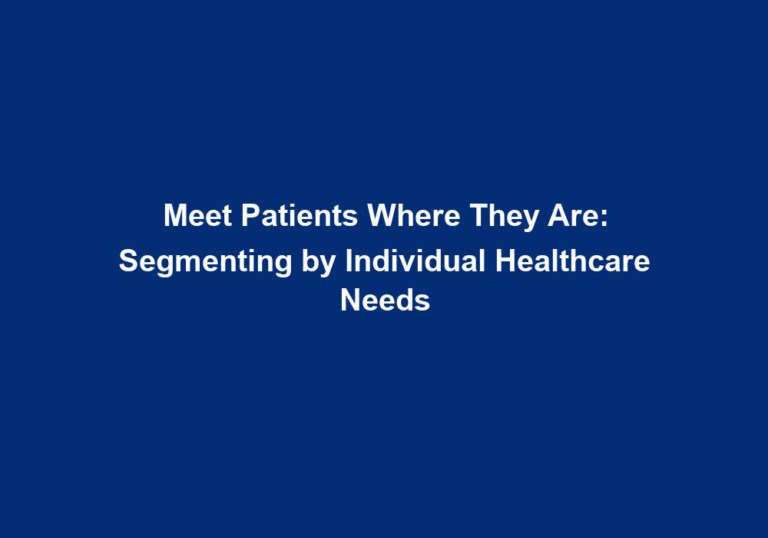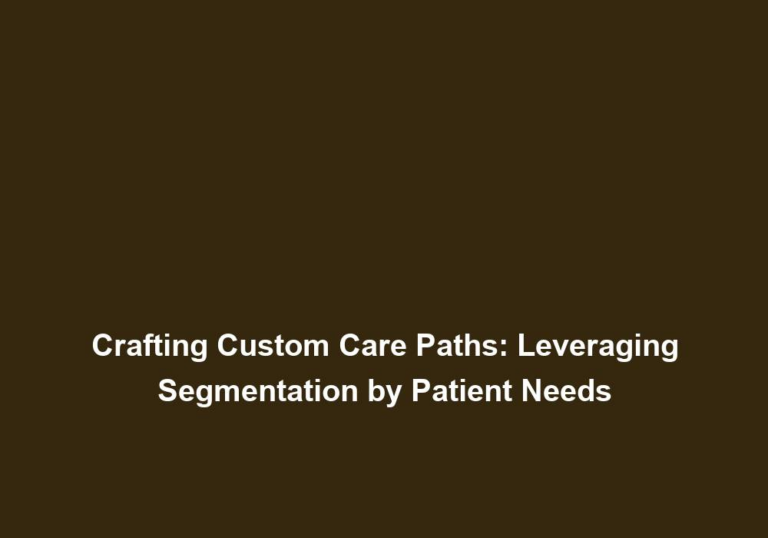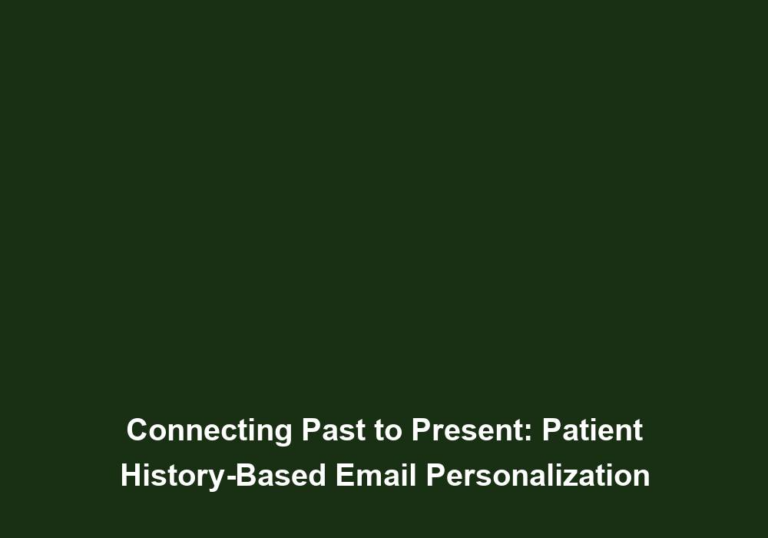Personalized Patient Pathways: Segmenting Emails by Patient Needs
In the modern healthcare landscape, personalized communication has become essential in providing quality patient care. With the advancement of technology and the increasing use of electronic communication, healthcare providers are now able to tailor their messages to individual patients’ needs, ensuring that the right information reaches the right person at the right time. One effective method for achieving this is by segmenting emails based on patient needs. In this article, we will explore the concept of personalized patient pathways through email segmentation and discuss its benefits for both patients and healthcare providers.
Understanding Email Segmentation
Email segmentation involves dividing an email subscriber list into smaller groups based on specific criteria. By segmenting patients’ emails, healthcare providers can customize the content they send to match the unique needs and interests of each segment. This approach allows for more targeted and relevant communication, leading to improved patient engagement and better health outcomes.
Segmenting emails effectively requires a deep understanding of patients’ needs and preferences. Here are some key factors to consider when segmenting emails based on patient needs:
1. Demographics
Demographic information such as age, gender, location, and language can help tailor email content to specific patient groups. For example, a pediatrician may send different emails to parents of infants and parents of teenagers, addressing their unique concerns and providing age-appropriate information. By understanding the demographics of their patients, healthcare providers can ensure that the content they deliver is relevant and resonates with each individual.
2. Medical Conditions
Segmenting emails based on medical conditions allows healthcare providers to deliver targeted information related to specific diagnoses. For instance, a cardiology clinic may send specialized emails to patients with heart conditions, offering tips for managing their condition, dietary recommendations, and updates on new treatment options. By segmenting emails based on medical conditions, healthcare providers can provide personalized support and education to patients, helping them better manage their health.
3. Treatment Plans
Patients undergoing specific treatments or procedures require customized communication to support their care journey. By segmenting emails based on treatment plans, healthcare providers can send relevant instructions, appointment reminders, and post-procedure recovery guidelines. This level of personalization helps patients stay informed and engaged throughout their treatment, leading to improved compliance and better health outcomes.
4. Engagement Level
Segmenting emails based on patients’ engagement level can help healthcare providers tailor their messages to match recipients’ level of interest and participation. For instance, patients who have recently interacted with educational resources may receive additional information or follow-up emails to further support their engagement. This targeted approach ensures that patients receive the right level of communication and support, encouraging them to actively participate in their healthcare journey.
5. Preferences and Interests
Understanding patients’ preferences and interests allows healthcare providers to deliver content that resonates with them. By segmenting emails based on preferences, providers can send information related to specific topics or activities that patients have indicated an interest in, fostering a stronger connection and encouraging ongoing engagement. This personalized approach shows patients that their needs and interests are valued, further enhancing their overall healthcare experience.
Benefits of Email Segmentation
Segmenting emails based on patient needs offers several benefits for both patients and healthcare providers:
-
Enhanced Personalization: Segmenting emails enables healthcare providers to deliver personalized content that is tailored to each patient’s specific needs. By understanding patients’ preferences, medical history, and treatment plans, providers can create more meaningful and relevant messages that resonate with the recipients. This level of personalization helps build trust and strengthens the provider-patient relationship.
-
Improved Patient Engagement: Personalized communication fosters stronger patient engagement. When patients receive emails that address their individual concerns, they are more likely to read, respond, and take action. By segmenting emails based on patient needs, healthcare providers can increase patient engagement and empower individuals to actively participate in managing their health. This active involvement leads to better health outcomes and improved patient satisfaction.
-
Increased Relevance: By delivering targeted content, healthcare providers can ensure that patients receive information that is most relevant to their current circumstances. Whether it’s educational resources, appointment reminders, or follow-up care instructions, segmenting emails allows providers to address patients’ immediate concerns and deliver timely information. This level of relevance helps patients feel supported and well-informed, enhancing their overall healthcare experience.
-
Better Health Outcomes: Personalized patient pathways through email segmentation can positively impact health outcomes. By providing patients with tailored information, healthcare providers can educate and empower individuals to make informed decisions about their health. This personalized approach to communication facilitates proactive healthcare management and can lead to improved patient outcomes. Patients who receive personalized emails are more likely to adhere to treatment plans, adopt healthy behaviors, and achieve better overall health.
Best Practices for Implementing Email Segmentation
To effectively implement email segmentation for personalized patient pathways, healthcare providers should consider the following best practices:
-
Collect Comprehensive Data: Ensure your patient database contains relevant and up-to-date information on demographics, medical conditions, treatment plans, and patient preferences. This data serves as the foundation for effective email segmentation. Regularly update and maintain this data to ensure accuracy and relevance.
-
Use an Email Marketing Platform: Invest in a robust email marketing platform that allows for easy segmentation and automation. This will streamline the process of creating and sending personalized emails to different patient segments. Look for features such as dynamic content, customizable templates, and analytics to optimize your email campaigns.
-
Develop Clear Communication Goals: Define the goals and objectives for each email segment. Whether it’s to educate, inform, or drive action, having a clear purpose for each email ensures that communication is focused and impactful. Tailor the tone, language, and content of each email to align with the desired outcomes for that specific segment.
-
Test and Optimize: Continuously test and refine your email segmentation strategies to improve engagement and effectiveness. Monitor key metrics such as open rates, click-through rates, and conversion rates to determine the success of your email campaigns. Use A/B testing to compare different approaches and iterate based on the results.
-
Secure Patient Data: Prioritize patient data security and adhere to relevant privacy regulations. Implement strict data protection measures to safeguard patient information and ensure compliance with healthcare industry standards. Regularly audit your data security protocols and keep up to date with the latest best practices in data privacy.
Conclusion
Personalized patient pathways through email segmentation have emerged as a powerful tool for enhancing patient communication and engagement in healthcare. By segmenting emails based on patient needs, healthcare providers can deliver tailored content that is relevant, informative, and timely. This approach not only improves patient outcomes but also strengthens the provider-patient relationship, leading to better overall healthcare experiences. Embracing email segmentation as part of a comprehensive communication strategy can contribute to a more patient-centric healthcare system.







